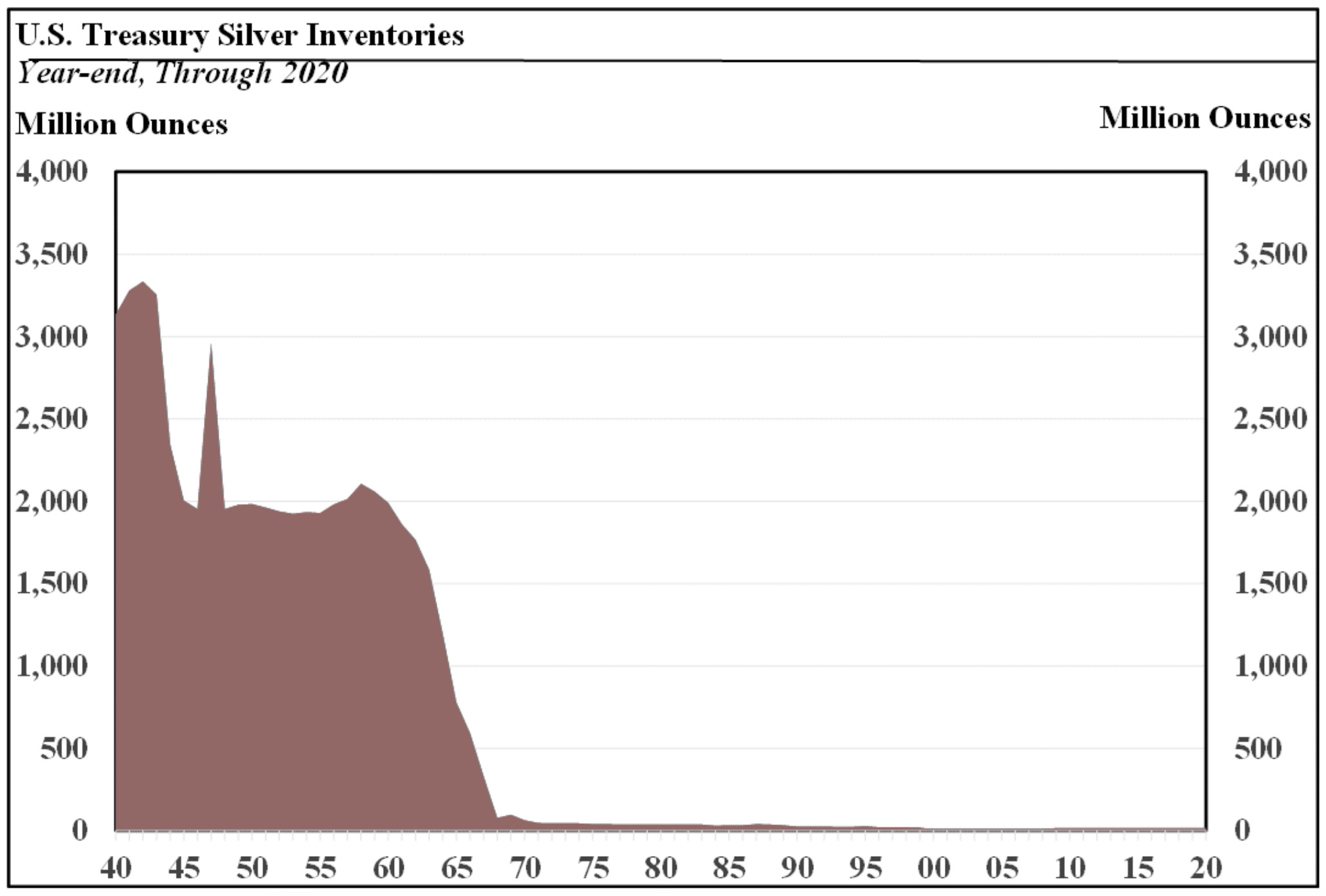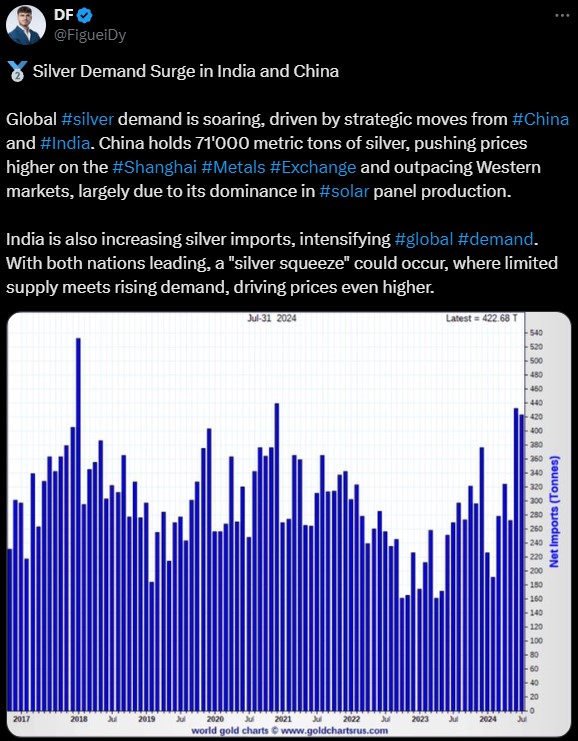(Kitco News) – Silver is finally coming to life after months of sideways trading and being overshadowed by gold’s record run of new highs, but with the gray metal now trading above $34, one hidden source of demand could propel silver to a new all-time high in the not-too-distant future.
As reported by The Jerusalem Post, silver’s uses in consumer electronics and renewable energy have been extensively covered, but its applications within the secretive realms of military and aerospace technology are less discussed.
“Recent analysis suggests that military usage of silver may be substantially greater than any other industry category, including electronics, solar panels, and investment demand combined,” the report said. “This information, brought to light by silver market experts, raises significant questions about the transparency of silver demand data and the potential impact on future silver prices.”
While central banks and large asset managers regularly report on silver inventories, purchases, and sales, the report noted that “five U.S. government agencies, including the Department of Defense, Department of Energy, Department of Interior, and the U.S. Geological Survey, have collectively stopped reporting on silver inventories since 1995-1996.”
Due to the secrecy of these operations and the assumption that other such developments have occurred under the guise of “black projects,” many in the precious metals community have grown wary of government-sourced data regarding the usage of the gray metal.
This includes its application in creating rockets and missiles, bombs and shells, fighter jets, satellites, tanks and submarines, torpedoes, night vision goggles, communication devices, radar systems, space technology, and nuclear technology.
As often cited by Andy Schectman, a renowned expert in the precious metals market and a regular interviewee with Kitco News, there are 500 ounces of silver in the tip of every tomahawk cruise missile, but the total amount used by the DoD is never reported, suggesting that demand for defense applications could be far higher than what’s assumed.
“The hidden military demand for silver could potentially outpace industrial applications as we progress through time and technology advances,” the report said. “Escalating geopolitical tensions and potential conflicts may drive this increase, making silver's role in military applications increasingly significant. This shift could have a substantial impact on the overall silver market, potentially influencing prices and supply dynamics.”
Some of the properties of silver that make it particularly appealing for military uses include its conductivity, antimicrobial properties, corrosion resistance, reflectivity, and heat conductivity, they noted.
“It is important to note that the military's demand for silver is classified, and there is limited public information available on the specific applications of silver in military equipment,” they added. “However, the properties listed above are likely to be among the most important factors driving the military's demand for silver.”
When combined with the known industrial uses – which include solar energy and photovoltaics, medical applications, photography, soldering and brazing alloys, battery technology, semiconductors, touch screens, and water purification – analysts argue that the price of silver could rise meaningfully in the years to come as the available supply gets absorbed by the growing number of use cases.
“Industrial uses account for more than half of annual silver demand worldwide over the last five years,” they noted. “The biggest consumers for industrial applications include the US, Canada, China, India, Japan, South Korea, Germany, and Russia.”
With the U.S. heavily reliant on silver imports, importing 6,500 million tons of silver in 2021 and currently getting 79% of its silver from outside sources – including 47% from Mexico and 23% from Canada between 2017 and 2020 – many see it as suspect that silver was “conspicuously absent from official critical materials lists published by the U.S. Department of Energy and the U.S. Geological Survey in 2022,” the report noted.
“Neither silver nor gold made the cut,” they added. “This absence has sparked debate, as silver’s strategic importance continues to grow across multiple industries, with demand surging globally.”

“With silver’s critical applications and growing industrial demand, many experts question whether its exclusion might warrant a reassessment,” the report said.
Indeed, this topic has become increasingly prominent in recent months as multiple countries have moved to label silver as a strategically important metal.
As reported previously by Kitco News, a draft copy of Russia’s federal budget indicates that the Russian government is looking to expand its holdings to include silver and platinum group metals.
“The formation of a reserve of refined precious metals as part of the State Fund of Russia will help ensure a balanced federal budget and stable economic development, as well as meet the industrial needs of the Russian Federation in the event of an emergency,” the Ministry of Finance was quoted in an article by Interfax, translated to English from Russian.
According to a report from Chinese media, “This is also the first time that Russia has explicitly mentioned silver as one of its reserve assets in its budget plan, indicating that silver is beginning to occupy an important position in Russia’s strategic resource reserve planning… As an energy powerhouse, Russia has a significant impact on world resource prices. Given the current turbulent international situation and stronger expectations for inflation in the future, other countries may also follow suit, which will undoubtedly generate strong demand for precious metals.”
The report added that while “silver, platinum, and palladium have remained severely undervalued in historical periods,” and “although the short-term impact on the market is not significant, from a long-term perspective of three to five years, these severely undervalued assets happen to have more investment value.”
And regarding the ongoing BRICS summit and reports indicating that the bloc plans to launch BRICS pay this coming Thursday, the Chinese media report said, “If this new payment system is linked to assets such as gold and silver, it will increase the monetary attributes of these precious metal assets, thereby also driving up the prices of precious metals such as silver.”
“One of the reasons Russia is now deploying reserves to metals like silver, platinum, and palladium is that these all have military applications,” wrote X user Weimar Silver Pilgrim. “It’s technically unknown, but most missiles are said to contain 10-20 oz of silver apiece.”
“In a STUNNING move, Russia's central bank has just become the 1st in recent times to announce #silver purchases,” noted X user Make Gold Great Again. “With only 3 oz of above ground #silver per human, other central banks better hurry before this #SilverSqueeze trend goes VIRAL AND STOCKS RUN OUT. Overheard by one uber-chic bank Chairman: ‘Silver is THE must-have central bank accessory this fall.’”
“Been saying BRICS/East has a very different historical relationship with silver than the West.
And now, Russia announced plans for silver,” added X user Graddhy. “Silver´s journey to become a part of the new coming global monetary system has now started, and it will drive the 3rd bull move.”
Both China and India have also been making strategic moves relating to silver, in what some have suggested is a calculated move by the two largest countries by population to drain the West of its silver reserves in response to years of price suppression, with many pointing to silver’s use in military applications as the impetus behind U.S. efforts to keep its price at lower levels.

As for the implications for the silver market, the report suggested that “The combination of significant military demand and diverse industrial applications could have profound implications for the silver market.”
“With substantial demand from both military and industrial sectors, the silver market may be tighter than previously thought,” they said. “ As awareness of total demand grows, it could drive silver prices higher. Silver's strategic importance in military and industrial applications may lead to increased government interest in securing supplies. And Questions arise about the accuracy and completeness of official silver demand data.”
“The true strategic importance of silver in military and industrial applications may be far greater than publicly acknowledged, making it a critical resource for national security, technological advancement, and industrial growth,” the report concluded. “The interplay between military demand, industrial applications, and investment interest will likely shape the future of the silver market, potentially leading to a significant revaluation of this versatile and indispensable metal.”
